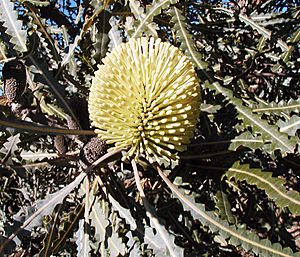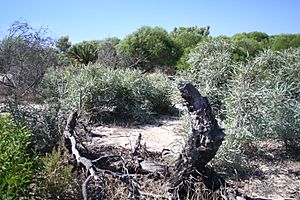Elegant banksia facts for kids
Quick facts for kids Elegant banksia |
|
|---|---|
 |
|
| Cultivated specimen, Perth | |
| Conservation status | |
| Scientific classification | |
| Genus: |
Banksia
|
| Species: |
elegans
|
| Synonyms | |
|
Sirmuellera elegans (Meisn.) Kuntze |
|
The Banksia elegans, also known as the elegant banksia, is a type of woody shrub. It grows only in a small part of Western Australia. This plant can reach up to 4 meters (about 13 feet) tall. It often grows new plants from its roots or trunk, which is called suckering. It rarely grows from seeds. Its yellow, round or oval flower spikes appear in spring and summer. A Swiss botanist named Carl Meissner first described the elegant banksia in 1856. It is most closely related to three other species in the Isostylis group of banksias.
Contents
What Does the Elegant Banksia Look Like?
The elegant banksia is a shrub that spreads out. It can grow up to 4 meters (13 feet) tall. It often sends up new shoots from its roots or trunk. The main trunk can be up to 15 centimeters (6 inches) wide. It has grey bark that looks like small tiles.
New stems are covered with fine hairs. As they get older, they become smooth. The plant mainly grows new parts in the summer. Its leaves are long, thin, and pale blue-green. They are about 20 to 46 centimeters (8 to 18 inches) long and 1.2 to 1.8 centimeters (0.5 to 0.7 inches) wide. The edges of the leaves have a clear saw-tooth pattern. They have triangular teeth and V-shaped dips.
The yellow flower spikes are oval or round. They can be 6 to 7 centimeters (2.4 to 2.8 inches) wide. Each flower spike has about 400 individual flowers. Most of these plants and their flowerheads do not produce seeds.
Where Does the Elegant Banksia Grow?
The elegant banksia is found in a small area of about 65 square kilometers (25 square miles). This area is north and west of Eneabba in Western Australia. It grows in small groups, with fewer than 100 plants in each group.
You can find these plants on flat, sandy plains. These areas are usually less than 50 meters (164 feet) above sea level. They are often near areas that get wet in winter. The plants around them are usually low shrubs or woodlands. Other banksia species like Banksia attenuata, B. prionotes, and B. menziesii often grow nearby.
How Does the Elegant Banksia Live and Grow?
The elegant banksia produces very few seeds. It mostly reproduces by sending up new shoots from its roots. This is called suckering. Even though it flowers a lot, it doesn't make many seeds. Also, many developing seeds often stop growing. One study found that a plant produced only about two seeds over sixteen years.
After a bushfire, these plants start flowering again after three years. They can regrow from large underground stems called lignotubers. They also send up new shoots from their roots. One study found no new seedlings after a bushfire. This suggests that the plant relies more on growing from its roots than from seeds.
Scientists have looked at how climate change might affect this plant. They found that its habitat might not shrink. It could even grow if the plant can move into new areas that become suitable for it.
Conservation Status
The Government of Western Australia's Department of Parks and Wildlife lists this banksia as "Priority Four". This means it is rare or almost threatened.
Growing Elegant Banksia at Home
If you want to grow elegant banksia from seeds, you don't need to do anything special to them. The seeds usually take between 19 and 48 days to sprout.



